职场必知的10个英文电邮礼仪
职场英语 写作英语电邮时实用的10个小贴士
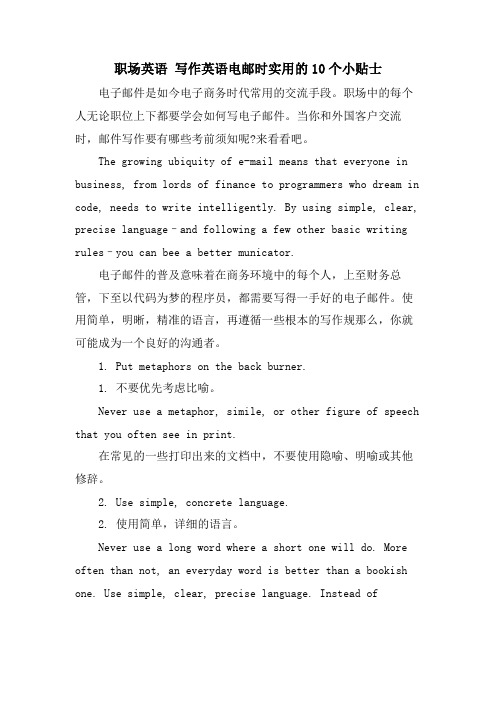
职场英语写作英语电邮时实用的10个小贴士电子邮件是如今电子商务时代常用的交流手段。
职场中的每个人无论职位上下都要学会如何写电子邮件。
当你和外国客户交流时,邮件写作要有哪些考前须知呢?来看看吧。
The growing ubiquity of e-mail means that everyone in business, from lords of finance to programmers who dream in code, needs to write intelligently. By using simple, clear, precise language–and following a few other basic writing rules–you can bee a better municator.电子邮件的普及意味着在商务环境中的每个人,上至财务总管,下至以代码为梦的程序员,都需要写得一手好的电子邮件。
使用简单,明晰,精准的语言,再遵循一些根本的写作规那么,你就可能成为一个良好的沟通者。
1. Put metaphors on the back burner.1. 不要优先考虑比喻。
Never use a metaphor, simile, or other figure of speech that you often see in print.在常见的一些打印出来的文档中,不要使用隐喻、明喻或其他修辞。
2. Use simple, concrete language.2. 使用简单,详细的语言。
Never use a long word where a short one will do. More often than not, an everyday word is better than a bookish one. Use simple, clear, precise language. Instead ofmentioning “the current situation,” explain exactly what it is.竟可能使用短的词语。
英文邮件,不可错过的礼貌用语!

英文邮件,不可错过的礼貌用语!展开全文你需要经常用英语给写邮件吗?如果是,那可要好好主意礼貌哦。
今天为大家带来十条职场常见的英语用句,放入邮件中立刻诚意满满,搭配简洁明了的邮件内容风味更加。
现在就来看看吧~1. 第一次给陌生同事写邮件:It's my pleasure to write to you. I am …2. 跟同事开会以后写邮件:As discussed during the meeting, ...3. 感谢同事回邮件:Thanks for your reply. (Thanks for your prompt reply)4. 告诉同事仅供参考:FYI (For your information) For your reference5. 让同事今天就回邮件:Could you please reply to me by EOD today?EOD=end of day6. 回别人的邮件回晚啦:Sorry for the delayed response. I've seen your mail but couldn't respond earlier due to...7. 邮件里带着个附件:Please kindly find attached/enclosed…8. 感谢别人的帮忙 (正式的说法):I would appreciate your help in this matter.9. 告诉别人有新消息会通知:I’ll keep you posted.10. 邮件末尾的结束语:Look forward to hearing from you soon. If you have any questions, please do not hesitate to contact me-------------------------------你试过用手机学习英语?怎么玩?搜索微信订阅号:旅游英语(aalyte)关注后还能0元试听+水平测试。
职场礼仪:E-mail的礼仪常识
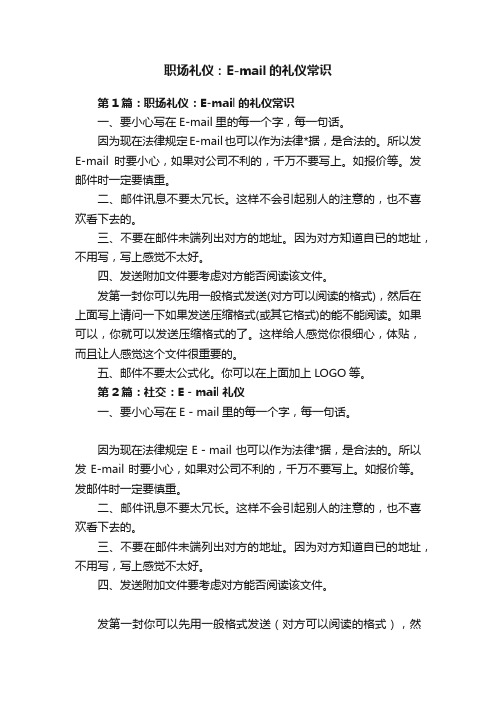
职场礼仪:E-mail的礼仪常识第1篇:职场礼仪:E-mail的礼仪常识一、要小心写在E-mail里的每一个字,每一句话。
因为现在法律规定E-mail也可以作为法律*据,是合法的。
所以发E-mail时要小心,如果对公司不利的,千万不要写上。
如报价等。
发邮件时一定要慎重。
二、邮件讯息不要太冗长。
这样不会引起别人的注意的,也不喜欢看下去的。
三、不要在邮件未端列出对方的地址。
因为对方知道自已的地址,不用写,写上感觉不太好。
四、发送附加文件要考虑对方能否阅读该文件。
发第一封你可以先用一般格式发送(对方可以阅读的格式),然后在上面写上请问一下如果发送压缩格式(或其它格式)的能不能阅读。
如果可以,你就可以发送压缩格式的了。
这样给人感觉你很细心,体贴,而且让人感觉这个文件很重要的。
五、邮件不要太公式化。
你可以在上面加上LOGO等。
第2篇:社交:E-mail礼仪一、要小心写在E-mail里的每一个字,每一句话。
因为现在法律规定E-mail也可以作为法律*据,是合法的。
所以发E-mail时要小心,如果对公司不利的,千万不要写上。
如报价等。
发邮件时一定要慎重。
二、邮件讯息不要太冗长。
这样不会引起别人的注意的,也不喜欢看下去的。
三、不要在邮件未端列出对方的地址。
因为对方知道自已的地址,不用写,写上感觉不太好。
四、发送附加文件要考虑对方能否阅读该文件。
发第一封你可以先用一般格式发送(对方可以阅读的格式),然后在上面写上请问一下如果发送压缩格式(或其它格式)的能不能阅读。
如果可以,你就可以发送压缩格式的了。
这样给人感觉你很细心,体贴,而且让人感觉这个文件很重要的。
五、邮件不要太公式化。
你可以在上面加上LOGO等。
第3篇:职场礼仪:办公礼仪常识我的许多朋友从农村来到城市,开始是做工人的,因为他们自强不息,进修了大专,开始做了办公室职员,有的是接线员,有的是秘书,更多的做了推销员,经常出入office。
她们都认为懂得职场礼仪是多么重要。
2021年职场英语 十种场合在邮件中的礼貌表达

职场英语十种场合在邮件中的礼貌表达职场英语:十种场合在邮件中的礼貌表达Hope you have a good trip back.祝旅途愉快。
How are you?你好吗?How is the project going?项目进行顺利吗?I suggest we have a call tonight at 9:30pm (China Time) with you and Brown. Please let me know if the time is okay for you and Ben.我建议我们今晚九点半和Brown小聚一下,你和Ben有没有空?I would like to hold a meeting in the afternoon about our development planning for the project A.今天下午我建议我们就A项目的发展计划开会讨论一下。
We’d like to have the meeting on Thu Oct 30. Same time.十月三十号(周四),老时间,开会。
Let’s make a meeting next Monday at 5:30 PM SLC time.下周一盐湖城时区下午五点半开会。
I want to talk to you over the phone regarding issues about report development and the XXX project.我想跟你电话讨论下报告进展和XXX项目的情况。
Should you have any problem aessing the folders, please let me know.如果存取文件有任何问题请和我联系。
Thank you and look forward to having your opinion on the estimation and schedule.谢谢你,希望能听到更多你对评估和日程计划的建议。
商务英语必看的邮件信函注意事项以及常用句式

英文商务邮件格式和礼仪收件人1.尽量不要把一堆邮箱地址都放在“收件人”栏里,这里只写跟邮件内容直接相关联系人的邮箱。
其他相关人员的邮箱可以添加到「抄送」或者「密送」里。
2.不是邮件内容的直接处理者,但也需要知道这件事情的人可以添加到抄送中。
只给需要的人抄送,有同学习惯性抄送一大堆相关和不相关的人,这是不可取的。
3.如果不想让收件人知道你同时把邮件也发给了某人,这种情况可以添加「密送」。
4.需要添加多个收件人或者抄送人的时候,一般会按照职位高低进行排序。
邮件标题1.一定不要发空白标题,这是非常不礼貌的行为。
相信大家也不会故意这么做,有可能是想先写好邮件再定标题,但最后直接空白标题就发出去了。
所以要养成良好的习惯,先把标题写好。
2.标题应「简明扼要」,能反应文章内容或者重要性,不宜冗长。
3.标题里应尽量不用特殊符号和长串的数字,以免邮件被放进对方垃圾邮件箱。
如非必要,尽量少用"urgent"等字眼。
4.回复对方邮件的时候,可以根据需要更改标题,不要一长串"RE"。
比如要回复收件人关于一款小黄人设计图的问题,邮件标题就可以简单地描述如下:RE:Art work of minions item附件1.如果有附件,标题写好马上上传附件,养成好习惯,不要等到邮件写完最后再上传,最后很可能会忘记。
相信不少人有过漏传附件的经历,邮件发出去才发现附件没上传。
2.邮件有附件时,应在正文里提醒收件人查收附件。
3.附件个数不宜过多,一般不超过4个。
数量较多的时候可以打包压缩成一个文件。
4.如果附件内容是特殊格式,应告知收件人打开方式,以免影响使用。
5.如果附件过大,最好拆分为多个邮件发送,或者通过网盘分享。
单封邮件附件过大可能发送不成功,或者被拦截。
比如,附件压缩包里是Art work的源文件,需要解压缩后用Illustrator打开,上传附件后可以在邮件中提醒如下:邮件内容1.首先是称呼:第一次联系尽量用「Dear XXX」作为称呼,不知道姓名只知道头衔的情况下,可用「Dear Title」,熟悉了之后也可以用「Hi XXX」或者「Hello XXX 」。
Email英语礼仪

Email英语礼仪Email英语礼仪,Email英语礼仪~ 一、关于邮件主题主题是接收者了解邮件的第一信息,因此要提纲挈领,使用有意义的主题行,这样可以让收件人迅速了解邮件内容并判断其重要性。
1.一定不要空白标题,这是最失礼的;2.标题要简短,不宜冗长,不要让outlook用,才能显示完你的标题;3. 标题要能反映文章的内容和重要性,切忌使用含义不清的标题,如“王先生收”;4.一封信尽可能只针对一个主题,不在一封信内谈及多件事情,以便于日后;5.可适当用使用大写字母或特殊字符(如“* !”等)来突出标题,引起收件人注意,但应适度,特别是不要随便就用“紧急”之类的字眼;6.回复对方邮件时,可以根据回复内容需要更改标题,不要RE、RE一大串。
二、关于称呼与问候1.恰当地称呼收件者,拿捏尺度1.1 邮件的开头要称呼收件人。
这既显得礼貌,也明确提醒某收件人,此邮件是面向他的,要求其给出必要的回应;在多个收件人的情况下可以称呼大家、ALL。
1.2 如果对方有职务,应按职务尊称对方,如“x经理”;如果不清楚职务,则应按通常的“x先生”、“x小姐”称呼,但要把性别先搞清楚。
1.3 不熟悉的人不宜直接称呼英文名,对级别高于自己的人也不宜称呼英文名。
称呼全名也是不礼貌的,不要逮谁都用个“Dear xxx”,显得很熟络。
2.Email开头结尾最好要有最简单的开头写一个“HI”,中文的写个“你好”;结尾常见的写个Best Regards,中文的写个“祝您顺利”之类的也就可以了。
俗话说得好,“礼多人不怪”,礼貌一些,总是好的,即便邮件中有些地方不妥,对方也能平静的看待。
三、职场的电子邮件礼仪1. Email正文要简明扼要,行文通顺Email正文应简明扼要的说清楚事情;如果具体内容确实很多,正文应只作摘要介绍,然后单独写个文件作为附件进行详细描述。
正文行文应通顺,多用简单词汇和短句,准确清晰的表达,不要出现让人晦涩难懂的语句。
Email Etiquette写英文电子邮件的礼节
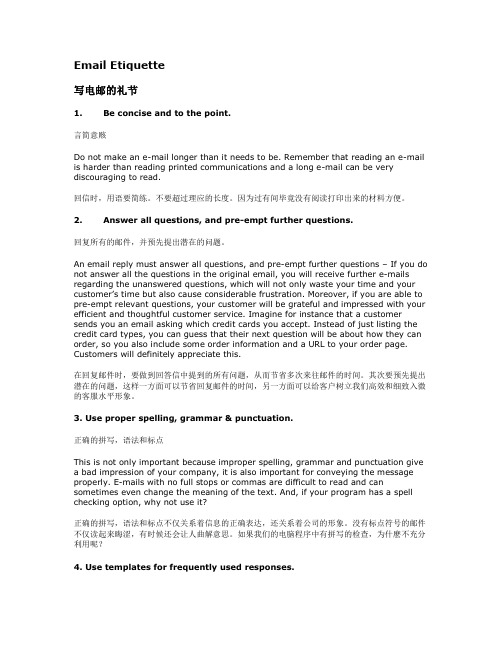
Email Etiquette写电邮的礼节1.Be concise and to the point.言简意赅Do not m ake an e-m ail longer than it needs to be. Rem ember that reading an e-m ail is harder than reading printed communications and a long e-m ail can be very discouraging to read.回信时,用语要简练。
不要超过理应的长度。
因为过有间毕竟没有阅读打印出来的材料方便。
2.Answer all questions, and pre-empt further questions.回复所有的邮件,并预先提出潜在的问题。
An em ail reply must answer all questions, and pre-empt further questions – If you do not answer all the questions in the original email, you will receive f urther e-m ails regarding the unanswered questions, which will not only waste your tim e and your custom er’s tim e but also cause considerable frustration. Moreover, if you are able to pre-em pt relevant questions, your custom er will be grateful and impressed with your efficient and thoughtful custom er service. Im agine for instance that a custom er sends you an em ail asking which credit cards you accept. Instead of just listing the credit card types, you can guess that their next question will be about how they can order, so you also include some order information and a URL to your order page. Custom ers will definitely appreciate this.在回复邮件时,要做到回答信中提到的所有问题,从而节省多次来往邮件的时间。
发英文邮件的礼貌用语

发英文邮件的礼貌用语随着全球化的发展和跨国交流的增加,发送英文邮件已成为商务和工作中常见的沟通方式。
尽管英文邮件的格式和礼貌用语有一定的灵活性,但在商务邮件中使用适当的礼貌用语仍然是非常重要的。
本文将为您介绍一些常用的英文邮件礼貌用语,以帮助您更好地与他人进行跨文化交流。
一、开场白1. Greetings (问候语)- Dear [Name],(亲爱的[姓名],)- Hello [Name],(你好,[姓名],)- Hi [Name],(嗨,[姓名],)- Good morning/afternoon/evening [Name],(早上/下午/晚上好,[姓名],)2. Introduction (自我介绍)- My name is [Your Name], and I am writing to... (我叫[你的姓名],写信是为了...)- I am [Your Position/Title] at [Company/Organization], and I would like to... (我在[公司/组织]任[职位/头衔],希望...)- I hope this email finds you well. (希望你一切都好。
)二、请求和提供信息1. Polite Requests (礼貌的请求)- Would you mind...? (你介意...)- Could you please...? (你能请...)- I would greatly appreciate it if you could... (如果你能...,我将非常感激。
)- If it's not too much trouble, could you...? (如果不是太麻烦,你能...吗?)2. Offering Assistance (提供帮助)- Please let me know if there's anything I can do to help. (如果有任何需要帮忙的地方,请告诉我。
Email的礼仪常识[推荐五篇]
![Email的礼仪常识[推荐五篇]](https://img.taocdn.com/s3/m/7967dc34a31614791711cc7931b765ce05087a2e.png)
Email的礼仪常识[推荐五篇]第一篇:Email的礼仪常识一、要小心写在e—mail里的每一个字,每一句话。
因为现在法律规定e—mail也可以作为法律证据,是合法的。
所以发e—mail时要小心,如果对公司不利的,千万不要写上。
如报价等。
发邮件时一定要慎重。
二、邮件讯息不要太冗长。
这样不会引起别人的注意的,也不喜欢看下去的。
三、不要在邮件未端列出对方的地址。
因为对方知道自已的地址,不用写,写上感觉不太好。
四、发送附加文件要考虑对方能否阅读该文件。
五、邮件不要太公式化。
你可以在上面加上logo等。
第二篇:英文商务email礼仪(范文模版)[分享]财务经理人应知商务电子邮件礼仪随着网络的普及,日常财务工作中电子邮件成为了必不可少的沟通工具之一,但是在实际工作中,经常遇到这样的问题,收到的一封邮件,题目竟然是“无标题”,偶尔收到一个还好,收到的多了,在后期查找时很不方便,下属公司报送的财务报表,不注明公司名称,下面是从网上看到一篇关于电子邮件的商务礼仪,和大家分享。
“在商务交往中要尊重一个人,首先就要懂得替他节省时间”,电子邮件礼仪的一个重要方面就是节省他人时间,只把有价值的信息提供给需要的人。
写Email就能看出其人为人处世的态度。
你作为发信人写每封Email的时候,要想到收信人会怎样看这封Email,时刻站在对方立场考虑,将心比心。
同时勿对别人之回答过度期望,当然更不应对别人之回答不屑一顾。
以下职业电子邮件中礼仪问题,希望能给您的工作带来帮助!一、关于邮件主题主题是接收者了解邮件的第一信息,因此要提纲挈领,使用有意义的主题行,这样可以让收件人迅速了解邮件内容并判断其重要性。
1.一定不要空白标题,这是最失礼的;2.标题要简短,不宜冗长,不要让outlook用,才能显示完你的标题;3.标题要能反映文章的内容和重要性,切忌使用含义不清的标题,如“王先生收”;4.一封信尽可能只针对一个主题,不在一封信内谈及多件事情,以便于日后整理;5.可适当用使用大写字母或特殊字符(如“*!”等)来突出标题,引起收件人注意,但应适度,特别是不要随便就用“紧急”之类的字眼;6.回复对方邮件时,可以根据回复内容需要更改标题,不要RE、RE一大串。
英文商务电邮技巧
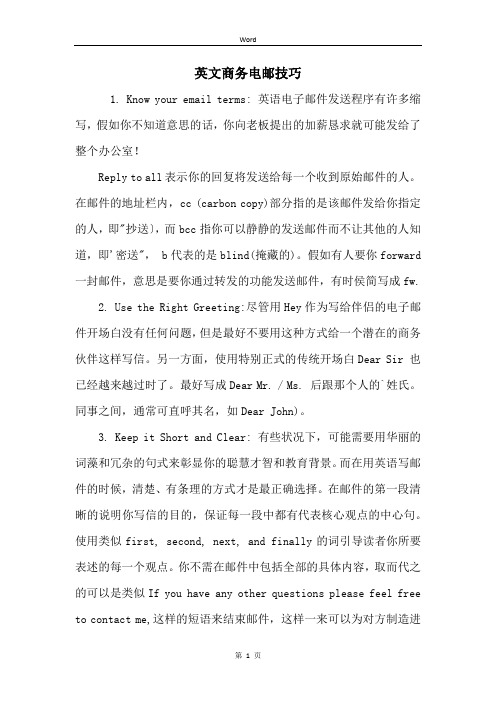
英文商务电邮技巧1. Know your email terms: 英语电子邮件发送程序有许多缩写,假如你不知道意思的话,你向老板提出的加薪恳求就可能发给了整个办公室!Reply to all表示你的回复将发送给每一个收到原始邮件的人。
在邮件的地址栏内,cc (carbon copy)部分指的是该邮件发给你指定的人,即"抄送〕,而bcc指你可以静静的发送邮件而不让其他的人知道,即'密送", b代表的是blind(掩藏的)。
假如有人要你forward 一封邮件,意思是要你通过转发的功能发送邮件,有时侯简写成fw.2. Use the Right Greeting:尽管用Hey作为写给伴侣的电子邮件开场白没有任何问题,但是最好不要用这种方式给一个潜在的商务伙伴这样写信。
另一方面,使用特别正式的传统开场白Dear Sir 也已经越来越过时了。
最好写成Dear Mr. / Ms. 后跟那个人的`姓氏。
同事之间,通常可直呼其名,如Dear John)。
3. Keep it Short and Clear: 有些状况下,可能需要用华丽的词藻和冗杂的句式来彰显你的聪慧才智和教育背景。
而在用英语写邮件的时候,清楚、有条理的方式才是最正确选择。
在邮件的第一段清晰的说明你写信的目的,保证每一段中都有代表核心观点的中心句。
使用类似first, second, next, and finally的词引导读者你所要表述的每一个观点。
你不需在邮件中包括全部的具体内容,取而代之的可以是类似If you have any other questions please feel free to contact me,这样的短语来结束邮件,这样一来可以为对方制造进一步沟通的前提。
4. Be polite and tactful: 懂得谦逊和精确传达信息的重要性。
I want.之类的词能避开则避开消失,相比之下,I would like显得更敬重对方。
韩国职场邮件礼仪文案英文

韩国职场邮件礼仪文案英文Email Etiquette for the Korean Workplace1. Use a polite salutation such as "Dear" or "Hello," followed by the recipient's name.2. Start the email with a formal greeting, such as "I hope this email finds you well."3. Maintain a professional tone throughout the email.4. Clearly state the purpose of the email in the subject line.5. Use formal and polite language in the body of the email.6. Avoid using abbreviations, emojis, or slang.7. Use titles such as Mr., Mrs., or Dr. when addressing someone.8. Express gratitude and appreciation when appropriate.9. Keep the email concise and to the point.10. Use proper grammar and spelling.11. Avoid using excessive exclamation points or capitalization, as it may come across as rude or too informal.12. Double-check before sending for any typos or errors.13. Respond to emails promptly, ideally within 24 hours.14. Avoid using overly personal language or sharing personal details unless necessary.15. Follow up on important matters in person or through a phone call ifdeemed necessary.16. Use a professional email signature that includes your name, title, and contact details.17. Be cautious with humor or sarcasm, as it may not translate well in written communication.18. Avoid sending irrelevant or unnecessary attachments.19. Request permission before forwarding someone else's email.20. Use a clear and organized structure in the email, using paragraphs for different topics or points.21. Avoid using email to address sensitive or confidential matters when possible.22. Make sure your email is easily readable, with a clear font type and size.23. Use a professional and appropriate email address.24. Avoid sending bulk or mass emails without proper context or relevancy.25. Always proofread before sending an email to avoid misunderstandings or misinterpretations.26. Address any mistakes or misunderstandings promptly and professionally.27. Remember that emails are a reflection of your professionalism and can have a lasting impact on your professional relationships.。
英文邮件礼仪
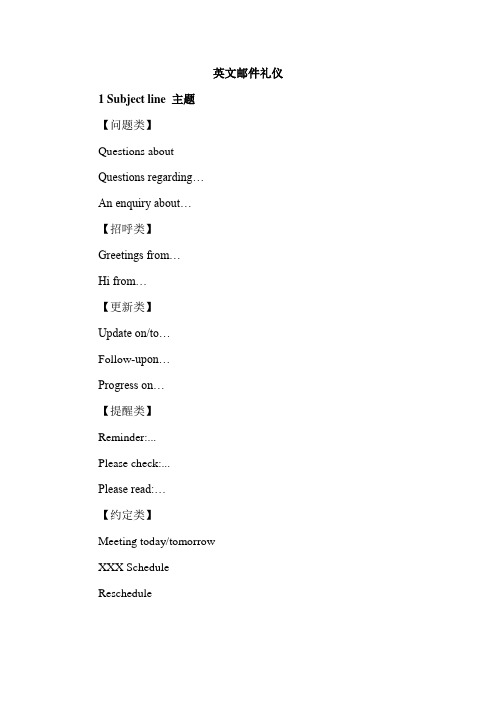
英文邮件礼仪1 Subject line 主题【问题类】Questions aboutQuestions regarding…An enquiry about…【招呼类】Greetings from…Hi from…【更新类】Update on/to…Follow-upon…Progress on…【提醒类】Reminder:...Please check:...Please read:…【约定类】Meeting today/tomorrowXXX ScheduleReschedule2 Salutation 称谓(1)跟对方邮件来往较多用Hi XX或者Hello XX,比如Hi Jessica。
这种方式通常用在双方关系很熟,或者已经和对方来往过很多次邮件的情况。
Hey+同上:注意,Hey用于非常熟的人,一般较少使用。
(2)一次联系或者不熟悉要正式一点,最好用“Dear+姓”,比如Dear Mr./Mrs. Green。
如果不知道对方(女性)是否已婚,用“Ms.” 来代替“Miss” 或“Mrs.” 最保险。
如果不知道对方姓氏或性别,使用“Dear Sir/Madam” 或“To whom it may concern”。
(3)收件人不止一个使用“Dear All”,给同学们可以写“Dear classmates”。
3 Main point 正文(1)开场白:Hope you are well/Hope this email find you well...回复开场白:Further to our conversation earlier……Thanks for your kind reply.Thanks for the update on the situation.Regarding...As per my email sent on xxxxPlease help to clarify....回复晚了,表达抱歉:Sorry for the late reply出了小差错,重新发送:在结尾加上"Sorry for any inconvenience caused"。
职场必知的10个电邮礼仪(英汉对照)
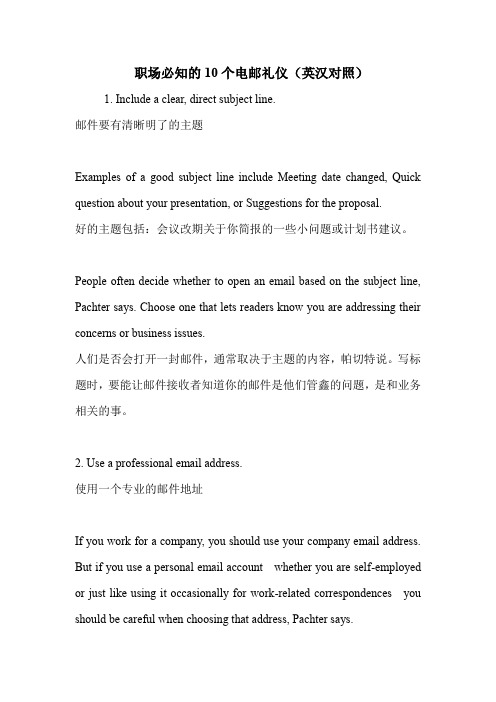
职场必知的10个电邮礼仪(英汉对照)1. Include a clear, direct subject line.邮件要有清晰明了的主题Examples of a good subject line include Meeting date changed, Quick question about your presentation, or Suggestions for the proposal.好的主题包括:会议改期关于你简报的一些小问题或计划书建议。
People often decide whether to open an email based on the subject line, Pachter says. Choose one that lets readers know you are addressing their concerns or business issues.人们是否会打开一封邮件,通常取决于主题的内容,帕切特说。
写标题时,要能让邮件接收者知道你的邮件是他们管鑫的问题,是和业务相关的事。
2. Use a professional email address.使用一个专业的邮件地址If you work for a company, you should use your company email address. But if you use a personal email account whether you are self-employed or just like using it occasionally for work-related correspondences you should be careful when choosing that address, Pachter says.帕切特指出,如果你为公司工作,你应该使用公司的电子邮件地址。
职场英语邮件书写常用语大全
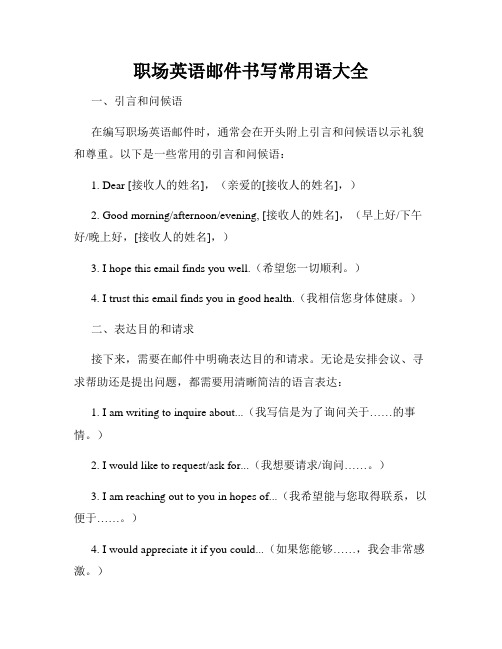
职场英语邮件书写常用语大全一、引言和问候语在编写职场英语邮件时,通常会在开头附上引言和问候语以示礼貌和尊重。
以下是一些常用的引言和问候语:1. Dear [接收人的姓名],(亲爱的[接收人的姓名],)2. Good morning/afternoon/evening, [接收人的姓名],(早上好/下午好/晚上好,[接收人的姓名],)3. I hope this email finds you well.(希望您一切顺利。
)4. I trust this email finds you in good health.(我相信您身体健康。
)二、表达目的和请求接下来,需要在邮件中明确表达目的和请求。
无论是安排会议、寻求帮助还是提出问题,都需要用清晰简洁的语言表达:1. I am writing to inquire about...(我写信是为了询问关于……的事情。
)2. I would like to request/ask for...(我想要请求/询问……。
)3. I am reaching out to you in hopes of...(我希望能与您取得联系,以便于……。
)4. I would appreciate it if you could...(如果您能够……,我会非常感激。
)三、提供细节和背景信息为了使邮件更加详细和清晰,可以提供一些背景信息和具体细节。
这有助于接收人更好地了解邮件的上下文和内容:1. Firstly, let me provide some background information...(首先,让我提供一些背景信息……)2. To give you some context,...(为了给您一些背景……)3. I would like to share with you some details regarding...(我想与您分享一些有关……的细节。
)四、请求回复和确认在邮件中,经常需要请求对方回复或确认接收信息。
在工作英文邮件常用语

在工作英文邮件常用语工作场合中,使用英语发送邮件的情况非常常见。
良好的邮件沟通不仅对于工作效率有着重要的影响,也能提升个人和团队的专业形象。
在这篇文章中,我们将介绍一些常用的工作英文邮件常用语和技巧,以帮助您更好地进行邮件沟通。
1. 开场白在邮件的开头,我们需要适当地使用礼貌用语来打招呼并引入邮件的主题。
常见的开场白包括:- Good morning/afternoon/evening,- Dear Mr./Mrs./Ms. (姓氏), (或直接用名字)- I hope this email finds you well.(祝福对方身体健康)- I am writing to inquire about...(我写信是想询问......)- I am writing to follow up on...(我写信是想跟进......)2. 说明目的在邮件的第一段中,我们需要简洁明了地说明邮件的目的。
以下是一些例子:- I am writing to request...(我写信是想请求......)- I am contacting you regarding...(我联系您是关于......)- I would like to inform you that...(我想告知您......)- I wanted to discuss...(我想讨论一下......)3. 提供详细信息接下来,在邮件的主体部分,我们需要提供关于问题或请求的详细信息。
在这一部分,使用简明扼要的语言,以确保对方能够明确理解。
以下是一些常用的表达方式:- To provide further details...(为了提供更多细节......)- In addition, I would like to mention...(此外,我想提及......)- It would be helpful if you could...(如果您能......将会很有帮助)- Could you please provide more information about...(您能否提供关于......更多的信息)4. 请求回复或行动在邮件的结尾,我们通常需要请求对方回复或采取行动。
英文邮件开头的礼貌用语
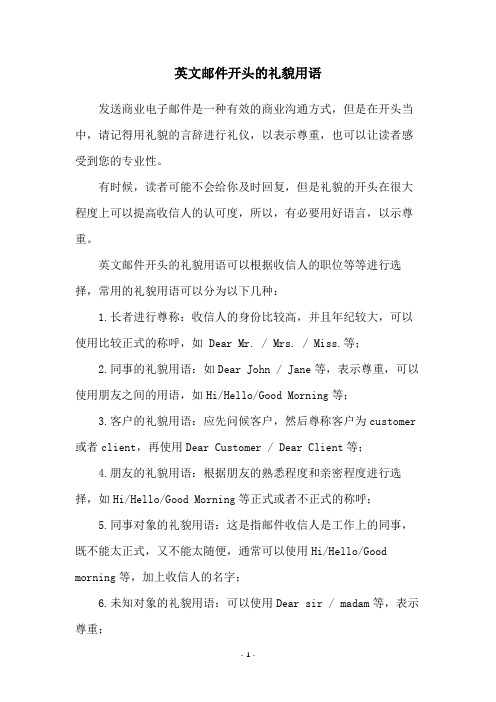
英文邮件开头的礼貌用语发送商业电子邮件是一种有效的商业沟通方式,但是在开头当中,请记得用礼貌的言辞进行礼仪,以表示尊重,也可以让读者感受到您的专业性。
有时候,读者可能不会给你及时回复,但是礼貌的开头在很大程度上可以提高收信人的认可度,所以,有必要用好语言,以示尊重。
英文邮件开头的礼貌用语可以根据收信人的职位等等进行选择,常用的礼貌用语可以分为以下几种:1.长者进行尊称:收信人的身份比较高,并且年纪较大,可以使用比较正式的称呼,如 Dear Mr. / Mrs. / Miss.等;2.同事的礼貌用语:如Dear John / Jane等,表示尊重,可以使用朋友之间的用语,如Hi/Hello/Good Morning等;3.客户的礼貌用语:应先问候客户,然后尊称客户为customer 或者client,再使用Dear Customer / Dear Client等;4.朋友的礼貌用语:根据朋友的熟悉程度和亲密程度进行选择,如Hi/Hello/Good Morning等正式或者不正式的称呼;5.同事对象的礼貌用语:这是指邮件收信人是工作上的同事,既不能太正式,又不能太随便,通常可以使用Hi/Hello/Good morning等,加上收信人的名字;6.未知对象的礼貌用语:可以使用Dear sir / madam等,表示尊重;7.上司的礼貌用语:可以用Dear Mr. / Mrs. / Miss.或者Hello等。
此外,英文邮件中,关于自我介绍的内容也是必不可少的,大多数情况下,自我介绍部分的首句话,也可以用礼貌的言辞来介绍自己,如:My name is… / I am… / I am writing to you on behalf of…等等。
总之,在发送商业电子邮件时,用礼貌用语是一定要遵守的礼仪,并且,恰当地使用礼貌用语,还可以给人留下专业而友善的印象,从而提升双方彼此的工作关系。
英文邮件开头的礼貌用语

英文邮件开头的礼貌用语在现代社会中,电子邮件已成为人们日常工作和交流的重要工具。
在写邮件时,一个恰当的开头礼貌用语能够为读者留下好的第一印象,彰显自己的专业素养和礼貌态度。
本文将介绍一些常见的英文邮件开头礼貌用语,帮助读者在撰写邮件时使用恰当的语言。
1. 问候语 (Greetings)在邮件开头,通常需要使用一些标准的问候语表示对收件人的尊重。
以下是一些常见的英文邮件开头问候语:- Dear Mr/Ms/Dr/Professor (亲爱的先生/女士/博士/教授)- Hello (你好)- Hi (嗨)- Good morning/afternoon/evening (早上/下午/晚上好)除了常规的问候语,你还可以根据具体情况使用其他适当的问候方式。
2. 自我介绍 (Introducing Yourself)在写邮件开头时,如果你和收件人不熟悉,或者以往没有过多的交流,可以通过自我介绍来让对方了解你的身份和背景。
以下是一些常见的自我介绍句式:- I am writing to introduce myself as...(我写信是为了介绍我自己,我是...)- I am contacting you on behalf of...(我代表...联系您)- I am a [job title] at [company/organization](我在某公司/机构担任某职位)通过自我介绍,能够明确表达你写邮件的目的,让收件人更好地理解你的来信。
3. 衷心祝福 (Expressions of Goodwill)给收件人表达祝福是邮件开头的另一个常见礼貌用语。
这可以增强与收件人的关系,并帮助建立友好的邮件交流。
以下是一些常见的表达衷心祝福的句式:- I hope this email finds you well(希望您一切安好)- I trust this email finds you in good health(希望您身体健康)- I hope you are enjoying the start of the week(希望您的一周开始愉快)- I wish you a pleasant day(祝您愉快的一天)这些表达方式能够体现你的关心和善意,为邮件交流增添一份温暖。
英语邮件礼貌用语

英语邮件礼貌用语邮件是电子化传播信息的重要方式之一,而邮件的礼貌用语则是在书写邮件时必不可少的一部分。
使用适当的礼貌用语可以展示您的教养和尊重,使您的邮件更加礼貌和专业。
本文将为您介绍一些常用的英语邮件礼貌用语。
请您参考以下内容:开头礼貌用语1. Dear + 对方的姓名:尊称对方,并用于正式场合或与陌生人的邮件往来,如:Dear Mr. Smith 或 Dear Ms. Johnson。
2. Hello + 对方的姓名:用于非正式场合或与熟悉的人的邮件往来,如:Hello John 或 Hello Emily。
3. Hi + 对方的姓名:用于非正式场合或与亲近的人的邮件往来,如:Hi David 或 Hi Sarah。
称呼用语1. Sir:用于对男性的正式称呼。
2. Madam:用于对女性的正式称呼。
3. Dear Sir/Madam:用于不知道对方性别或与陌生人的正式场合。
感谢用语1. Thank you for + 名词或动词的现在分词:感谢对方给予的帮助、支持或机会,如:Thank you for your assistance(感谢您的帮助)或Thank you for considering my request(感谢您考虑我的请求)。
2. I appreciate + 名词或动词的现在分词:表达对对方的感激之情,如:I appreciate your time(谢谢您的时间)或 I appreciate your understanding(感谢您的理解)。
请求用语1. Could you + 动词原形:委婉地表达请求,如:Could you please send me the report?(您能否请把报告发给我?)或 Could you provide more information?(是否能提供更多信息?)。
2. Would you mind + 动词动名词:用于委婉地提出请求,如:Would you mind sending me the document?(您介意把文件发送给我吗?)或 Would you mind helping me with this matter?(您介意帮我处理这个问题吗?)。
英文写Email常用礼貌用语
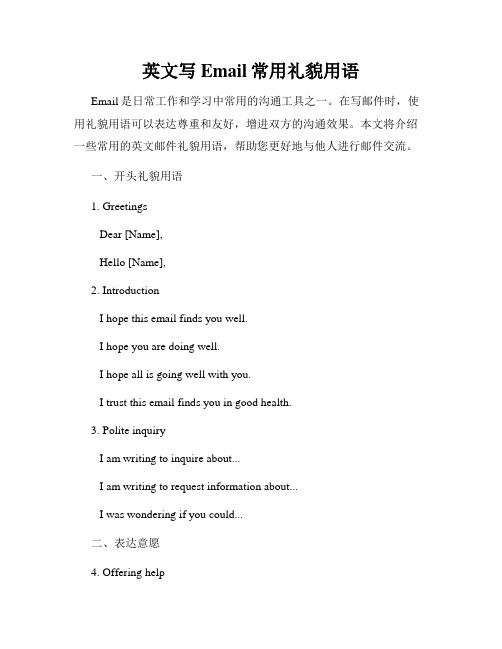
英文写Email常用礼貌用语Email是日常工作和学习中常用的沟通工具之一。
在写邮件时,使用礼貌用语可以表达尊重和友好,增进双方的沟通效果。
本文将介绍一些常用的英文邮件礼貌用语,帮助您更好地与他人进行邮件交流。
一、开头礼貌用语1. GreetingsDear [Name],Hello [Name],2. IntroductionI hope this email finds you well.I hope you are doing well.I hope all is going well with you.I trust this email finds you in good health.3. Polite inquiryI am writing to inquire about...I am writing to request information about...I was wondering if you could...二、表达意愿4. Offering helpIf you need any further assistance, please feel free to ask. Please let me know if there is anything I can do to help.I would be happy to assist you in any way I can.5. Asking for permissionCould you please...Would it be possible to...I would like to...6. Requesting a favorI would greatly appreciate it if you could...I would be grateful if you could...It would be a great help if you could...三、感谢和回复7. ThankingThank you for your prompt response.Thank you for your attention to this matter.I really appreciate your help.8. Responding to a requestI will take care of it right away.I will get back to you as soon as possible.I will do my best to...四、表达道歉和延迟9. ApologizingI apologize for any inconvenience caused.I am sorry for the delay in responding.I am sorry for any misunderstanding.10. Explaining delay or problemDue to [reason], I will need more time to...I am currently dealing with [issue], so it may take some time to...We are experiencing technical difficulties, but we are working on resolving them.五、结束礼貌用语11. ClosingThank you again for your assistance.Thank you for your attention to this matter.I look forward to hearing from you soon.12. FarewellBest regards,Kind regards,Sincerely,附:常用信件缩写词• FYI - For Your Information• ASAP - As Soon As Possible• RSVP - Répondez s'il vous plaît (Please reply)• EOM - End of Message (用于邮件主题,表示邮件正文中没有额外内容)总结:在写Email时,使用礼貌用语是非常重要的。
职场英语:十种场合在邮件中的礼貌表达

职场英语:十种场合在邮件中的礼貌表达职场英语:十种场合在邮件中的礼貌表达1. Greeting message祝福Hope you have a good trip back.祝旅途愉快。
How are you?你好吗?How is the project going?项目进行顺利吗?2. Initiate a meeting发起会议I suggest we have a call tonight at 9:30pm (China Time) with you and Brown. Please let me know if the time is okay for you and Ben.我建议我们今晚九点半和Brown小聚一下,你和Ben有没有空?I would like to hold a meeting in the afternoon about our development planning for the project A.今天下午我建议我们就A项目的发展计划开会讨论一下。
We’d like to have the meeting on Thu Oct 30. Same time.十月三十号(周四),老时间,开会。
Let’s make a meeting next Monday at 5:30 PM SLC time.下周一盐湖城时区下午五点半开会。
I want to talk to you over the phone regarding issues about report development and the XXX project.我想跟你电话讨论下报告进展和XXX项目的情况。
3. Seeking for more information/feedbacks/suggestions咨询信息/反馈/建议Should you have any problem accessing the folders, pleaselet me know.如果存取文件有任何问题请和我联系。
- 1、下载文档前请自行甄别文档内容的完整性,平台不提供额外的编辑、内容补充、找答案等附加服务。
- 2、"仅部分预览"的文档,不可在线预览部分如存在完整性等问题,可反馈申请退款(可完整预览的文档不适用该条件!)。
- 3、如文档侵犯您的权益,请联系客服反馈,我们会尽快为您处理(人工客服工作时间:9:00-18:30)。
10 email etiquette rules every professional should knowThe average US employee spends about a quarter of the work week combing through the hundreds of emails we all send and receive every day.But despite the fact that we're glued to our reply buttons, career coach Barbara Pachter says plenty of professionals still don't know how to use email appropriately.In fact, because of the sheer volume of messages we're reading and writing each day, we may be more prone to making embarrassing errors — and those mistakes can have serious professional consequences.Pachter outlines the basics of modern email etiquette in her book "The Essentials Of Business Etiquette." We pulled out the most essential rules you need to know.1. Include a clear, direct subject line.Examples of a good subject line include "Meeting date changed," "Quick question about your presentation," or "Suggestions for the proposal." "People often decide whether to open an email based on the subject line," Pachter says. "Choose one that lets readers know you are addressing their concerns or business issues."2. Use a professional email address.If you work for a company, you should use your company email address. But if you use a personal email account — whether you are self-employed or just like using it occasionally for work-related correspondences — you should be careful when choosing that address, Pachter says.You should always have an email address that conveys your name so that the recipient knows exactly who is sending the email. Never use email addresses (perhaps remnants of your grade-school days) that are not appropriate for use in the workplace, such as "babygirl@..." or "beerlover@..." — no matter how much you love a cold brew.3. Think twice before hitting 'reply all.'No one wants to read emails from 20 people that have nothing to do with them. Ignoring the emails can be difficult, with many people getting notifications of new messages on their smartphones or distracting pop-up messages on their computer screens. Refrain from hitting "reply all" unless you really think everyone on the list needs to receive the email, Pachter says.4. Use professional salutations.Don't use laid-back, colloquial expressions like, "Hey you guys," "Yo," or "Hi folks.""The relaxed nature of our writings should not affect the salutation in an email," she says. "Hey is a very informal salutation and generally it should not be used in the workplace. And Yo is not okay either. Use Hi or Hello instead."She also advises against shortening anyone's name. Say "Hi Michael," unless you're certain he prefers to be called "Mike."5. Reply to your emails — even if the email wasn't intended for you.It's difficult to reply to every email message ever sent to you, but you should try to, Pachter says. This includes when the email was accidentally sent to you, especially if the sender is expecting a reply. A reply isn't necessary but serves as good email etiquette, especially if this person works in the same company or industry as you.Here's an example reply: "I know you're very busy, but I don't think you meant to send this email to me. And I wanted to let you know so you can send it to the correct person."6. Proofread every message.Your mistakes won't go unnoticed by the recipients of your email. "And, depending upon the recipient, you may be judged for making them," Pachter says.Don't rely on spell-checkers. Read and re-read your email a few times, preferably aloud, before sending it off."One supervisor intended to write 'Sorry for the inconvenience,'" Pachter says. "But he relied on his spell-check and ended up writing 'Sorry for the incontinence.'"7. Add the email address last."You don't want to send an email accidentally before you have finished writing and proofing the message," Pachter says. "Even when you are replying to a message, it's a good precaution to delete the recipient's address and insert it only when you are sure the message is ready to be sent."8. Double-check that you've selected the correct recipient.Pachter says to pay careful attention when typing a name from your address book on the email's "To" line. "It's easy to select the wrong name, which can be embarrassing to you and to the person who receives the email by mistake."9. Keep your fonts classic.Purple Comic Sans has a time and a place (maybe?), but for businesscorrespondence, keep your fonts, colors, and sizes classic.The cardinal rule: Your emails should be easy for other people to read."Generally, it is best to use 10- or 12- point type and an easy-to-read font such as Arial, Calibri, or Times New Roman," Pachter advises. As for color, black is the safest choice.10. Nothing is confidential — so write accordingly.Always remember what former CIA chief General David Petraeus apparently forgot, warns Pachter: Every electronic message leaves a trail."A basic guideline is to assume that others will see what you write," she says, "so don't write anything you wouldn't want everyone to see." A more liberal interpretation: Don't write anything that would be ruinous to you or hurtful to others. After all, email is dangerously easy to forward, and it's better to be safe than sorry.vt. 校对,校勘vi. 做校对工作∙recipient[ri'sipiənt]videon. 容器,接受者;容纳者adj. 容易接受的,感受性强的∙inconvenience[,inkən'vi:njəns]videon. 不便;麻烦vt. 麻烦;打扰∙accidentally[,æksi'dentli]videoadv. 意外地;偶然地∙embarrassing[im'bærəsiŋ]videoadj. 使人尴尬的;令人为难的。
